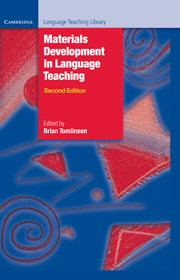Book contents
- Frontmatter
- Contents
- Preface
- Glossary of basic terms for materials development in language teaching
- Acknowledgements
- 1 Introduction: principles and procedures of materials development
- Part A Data collection and materials development
- 2 Using corpora in the language classroom
- 3 Concordances in the classroom without a computer: assembling and exploiting concordances of common words
- 4 Telling tails: grammar, the spoken language and materials development
- Comments on Part A
- Part B The process of materials writing
- 5 A framework for materials writing
- 6 Writing course materials for the world: a great compromise
- 7 How writers write: testimony from authors
- Comments on Part B
- Part C The process of materials evaluation
- 8 The analysis of language teaching materials: inside the Trojan Horse
- 9 Macro- and micro-evaluations of task-based teaching
- 10 What do teachers really want from coursebooks?
- 11 The process of evaluation: a publisher’s view
- Comments on Part C
- Part D The electronic delivery of materials
- 12 Developing language-learning materials with technology
- 13 New technologies to support language learning
- Comments on Part D
- Part E Ideas for materials development
- 14 Seeing what they mean: helping L2 readers to visualise
- 15 Squaring the circle – reconciling materials as constraint with materials as empowerment
- 16 Lozanov and the teaching text
- 17 Access-self materials
- Comments on Part E
- Conclusions
- Recommended reading
- Index
9 - Macro- and micro-evaluations of task-based teaching
Published online by Cambridge University Press: 09 February 2023
- Frontmatter
- Contents
- Preface
- Glossary of basic terms for materials development in language teaching
- Acknowledgements
- 1 Introduction: principles and procedures of materials development
- Part A Data collection and materials development
- 2 Using corpora in the language classroom
- 3 Concordances in the classroom without a computer: assembling and exploiting concordances of common words
- 4 Telling tails: grammar, the spoken language and materials development
- Comments on Part A
- Part B The process of materials writing
- 5 A framework for materials writing
- 6 Writing course materials for the world: a great compromise
- 7 How writers write: testimony from authors
- Comments on Part B
- Part C The process of materials evaluation
- 8 The analysis of language teaching materials: inside the Trojan Horse
- 9 Macro- and micro-evaluations of task-based teaching
- 10 What do teachers really want from coursebooks?
- 11 The process of evaluation: a publisher’s view
- Comments on Part C
- Part D The electronic delivery of materials
- 12 Developing language-learning materials with technology
- 13 New technologies to support language learning
- Comments on Part D
- Part E Ideas for materials development
- 14 Seeing what they mean: helping L2 readers to visualise
- 15 Squaring the circle – reconciling materials as constraint with materials as empowerment
- 16 Lozanov and the teaching text
- 17 Access-self materials
- Comments on Part E
- Conclusions
- Recommended reading
- Index
Summary
Introduction
Task-based language teaching (TBLT) constitutes a strong form of communicative language teaching. It aims to develop learners’ knowledge of a second language (L2) and their ability to use this knowledge in communication by engaging them in a series of communicative tasks. It differs from other approaches in that it does not attempt to teach learners predetermined linguistic items (i.e. vocabulary and grammar). TBLT is based on a view of language learning that claims that an L2 is best learned through learners’ efforts to communicate with it. Central to an understanding of TBLT is the concept of ‘task’. Therefore, I will begin by a definition of this pedagogic construct .
Defining ‘task’
Various definitions of a ‘task’ have been provided (see Ellis 2003 : 4–5) but most of these indicate that for a language-teaching activity to be a ‘task’, it must satisfy the following criteria:
1. The primary focus should be on ‘meaning’ (by which is meant that learners should be mainly concerned with processing both the semantic and pragmatic meaning of utterances).
2. There should be some kind of ‘gap’ (i.e. a need to convey information, to express an opinion or to infer meaning).
3. Learners should largely have to rely on their own resources – linguistic and non-linguistic – in order to complete the activity (i.e. the task materials do not dictate what linguistic forms are to be used).
4. There is a clearly defined outcome other than the use of language (i.e. the language serves as the means for achieving the outcome, not as end in its own right).
On the basis of such criteria, a distinction can be made between a ‘task’ and ‘a situational grammar exercise’. Whereas the latter may satisfy criteria (2) and (3), it does not satisfy (1) as the learners know that the main purpose of the activity is to practise correct language rather than to process messages for meaning, nor does it satisfy (4) as the outcome is primarily the use of correct language. See Ellis ( 2010 ) for a detailed account and examples of the distinction between situational grammar exercises and tasks.
- Type
- Chapter
- Information
- Materials Development in Language Teaching , pp. 212 - 235Publisher: Cambridge University PressPrint publication year: 2011
- 13
- Cited by



